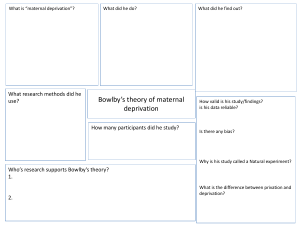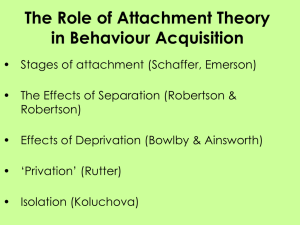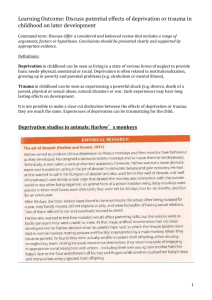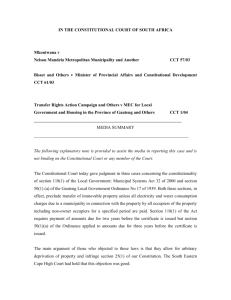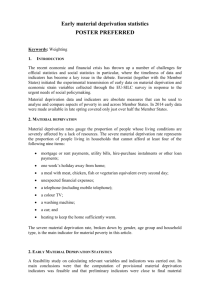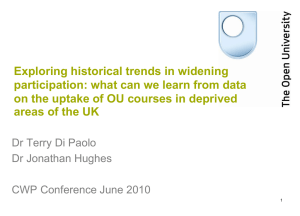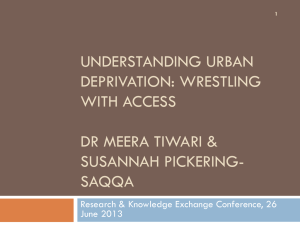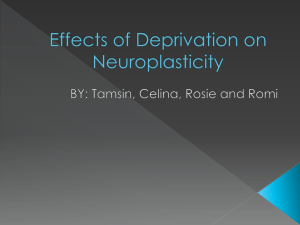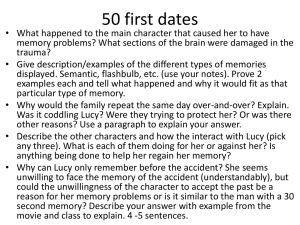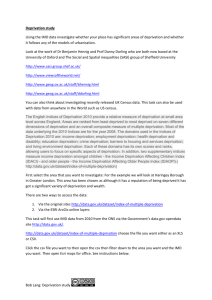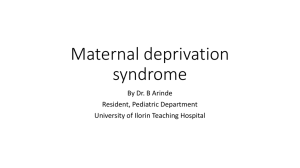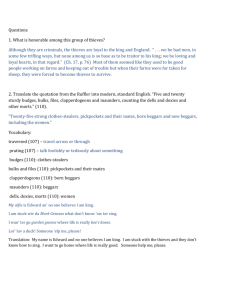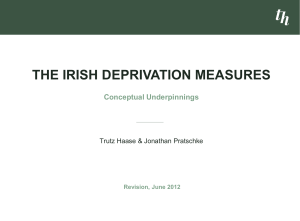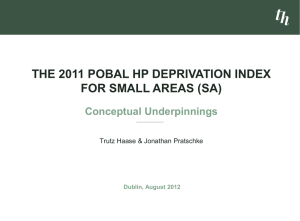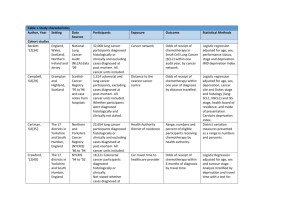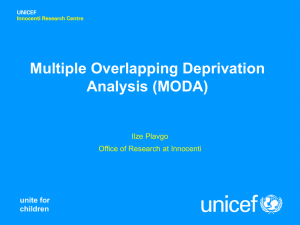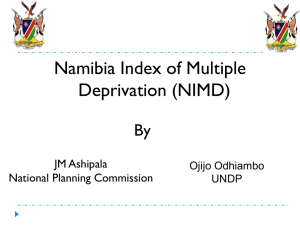Deprivation and Privation
advertisement
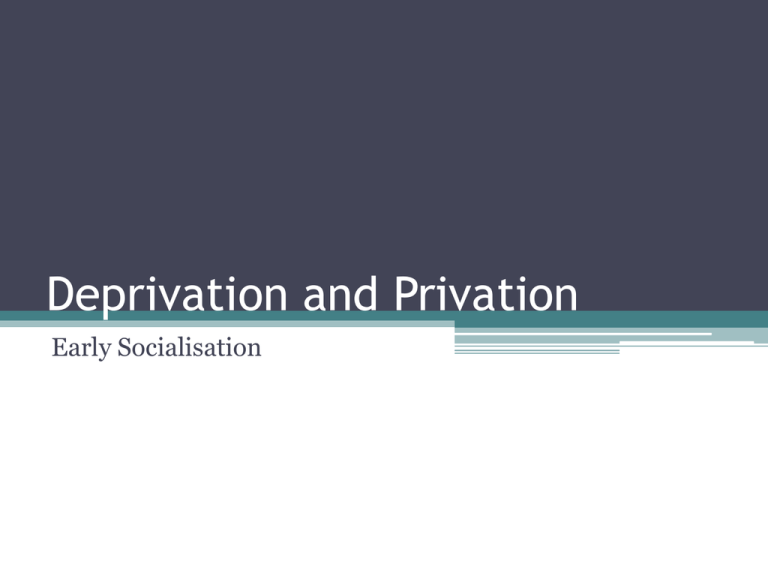
Deprivation and Privation Early Socialisation Separation and Deprivation • Separation – When the infant is apart from the PAF ie day care, babysitters, grandparents, etc. ▫ This will not normally lead to any issues so long as the PAF returns. • Deprivation – when the infant is separated from the PAF but has no substitute caregiver. ▫ Can have more serious consequences. Bowlby, 1944, The 44 Thieves Study • Created detailed records of 2 groups of children: thieves and a control group. • The thieves lacked empathy and a sense of responsibility. 14 of them were diagnosed as affectionless psychopaths. • Control group – maladjusted but didn’t lack empathy or sense of responsibility. • The children and their parents were interviewed re. early separation. Separation from mother before 2 y.o Frequent None Total Affectionless thieves 12 (86%) 2 (14%) 14 Other thieves 5 (17%) 25 (83%) 30 All thieves 17(39%) 27 (61%) 44 Control group 2 (4%) 42 (96%) 44 PDD Cycle – Robertson and Bowlby, 1952 • Protest – distress – trying to get caregiver to return • Despair – gives up hope that they will return. • Detachment – becomes more comfortable with others and will become more sociable. However, they did not welcome their mother back in the ‘normal’ way. Robertsons’ Case Studies (1967-1973) • 5 children, under the age of 3, separated from their family while mothers were in hospital. • 4 fostered by the Robertsons, 1 enrolled in a residential nursery for 9 days. • The Robertsons kept the childrens’ routines and their father often visited. Joyce Robertson provided emotional comfort when needed. • The foster children showed some signs of distress but seemed well adjusted and didn’t show any signs of PDD cycle. • They accepted their mother back readily. John – residential nursery • Initially confused. Tried to get attention from the workers but found it difficult to compete with more assertive children. • Sought comfort in an oversized teddy bear. This didn’t work. • Eventually John broke down and refused food, drink, play and stopped seeking attention. • His father visited for the first week but eventually John rejected him. • When his mother returned he struggled to get away from her. • For months after he had very angry outbursts towards his mother. • The PDD cycle Maternal Deprivation Hypothesis, 1953. • Mother’s emotional care required for mental stability and health. • If there is no emotional replacement during prolonged or frequent separations infants will become emotionally disturbed. • Critical period is before 2 ½ years but there is a continuing risk up to the age of 5. Evaluation • Hospitals began to allow children in to see parents where before it had been banned. However, • Other studies have suggested that recovery is possible. (Bowlby, 1955 TB children) Privation • Rutter (1972) Maternal Deprivation Re-Assessed • Lack of attachment figure completely (as opposed to loss). • May have irreversible consequences. • These children would not show signs of distress when separated from anyone. • As children – clingy, dependent, attention-seeking, indiscriminate friendliness. • As adults – inability to follow rules, form lasting relationships, feel guilt, anti-social behaviour, deficit in emotional, intellectual and physical growth. Genie Case Study – Curtiss, 1977 • During development (14-20mnths) Genie diagnosed as mildly retarded. • 1-13y.o. Genie was locked in her bedroom and illtreated by her father. • Kept in nappies and tied to a potty chair or bound in a sleeping bag and kept in an enclosed cot. • Actively tried to keep her quiet (violence and growling if she tried to speak) which prevented her from ever being able to speak. • The rest of the family were also controlled and banned from leaving the house. Genie (2) • Mother left father and sought help. • Couldn’t stand upright, vocab 20 words, social maturity of a 1 yo, could only understand her own name, didn’t know how to chew, was not toilet trained. • After few months – give 1 word answers, learned to use sign language and could dress herself but still wasn’t developing ‘normally’. • Returned to care of mother but eventually went back to series of foster care – abused and regressed. • Still lives in sheltered accommodation. Andrei and Vanya – Koluchova, 1976 • Czech twins – mother died soon after birth – looked after by social work and aunt for first 18 months – development normal. • Stepmother locked them in a cupboard for 5 ½ years. • Discovered at 7 yo – physically underdeveloped, rickets and lacked speech. • Cared for by two loving and dedicated women. • Both boys are now ‘normal’ with an education, good job and family. • Why? Institutionalised children • Quinton et al, 1985 – 50 women raised in care, 50 women in a loving home. The care group struggled with being parents themselves – their children more likely to spend time in care than the control group. • Triseltiotis, 1984 – effects of privation may be reversible if placed in a loving, stable home. • Skeels and Dye, 1939 and Skodak and Skeels, 1949 – children moved from orphanages to homes for the mentally retarded saw their IQs rise whereas those who remained in the orphanage dropped – retarded adults providing the missing emotional care? Reactive Attachment Disorder • Recognised mental illness • Sufferers cannot create emotional bonds or relationships, lack intimacy and affection, may lack sense of conscience. • Children learn that the world is unsafe and so create barriers, lashing out at those who attempt to get close. • This can be caused due to deprivation or privation but can also occur when the relationships with PAF is difficult and doesn’t recover. Hodges and Tizard, 1989 • Aims – what’s best adoption or returning home? What are the long term effects of deprivation/privation? • M&P – longitudinal study following 65 children. By 4 yo – 24 adopted, 15 returned home, 26 remained in institution. Assessed for social and emotional competence at 4, 8 and 16 years. • Results – significant difference in attachment between adopted and restored children. Exinstitution children had poorer relationships with peers and were more likely to be bullies. Conclusion • In terms of family relationships deprivation/privation effects need not be long lasting if they are put into a loving and stable home. • Social development with peers is affected by early attachment. Clear cut? • Discuss the research we have looked at for both deprivation and privation. • Split the research into two columns – those that suggest they do have long term, irreversible effects and what they are and those that suggest they don’t. • Develop a list of pros and cons for these studies based on their methodologies. Use your knowledge from unit 2 to help. • Remember: Psychology is all about learning things and then slagging it off!
